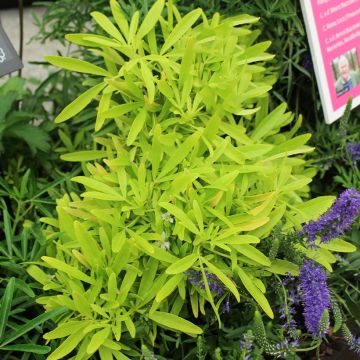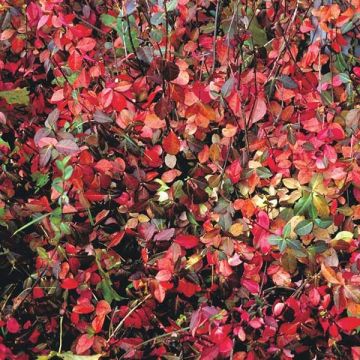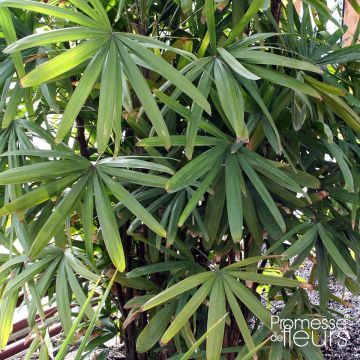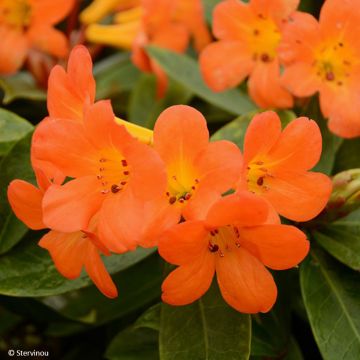

Choisya ternata Scented Gem - Mexican Orange Blossom


Choisya ternata Scented Gem - Mexican Orange Blossom
Choisya ternata Scented Gem - Mexican Orange Blossom
Choisya ternata x arizonica Scented Gem (Lissbrid)
Mexican Orange Blossom
This item cannot be shipped to the selected country
Delivery charge from €5.90
Delivery charge from €5.90
More information
Schedule delivery date,
and select date in basket
This plant carries a 24 months recovery warranty
More information
We guarantee the quality of our plants for a full growing cycle, and will replace at our expense any plant that fails to recover under normal climatic and planting conditions.
From €5.90 for pickup delivery and €6.90 for home delivery
Express home delivery from €8.90.
From €5.90 for pickup delivery and €6.90 for home delivery
Express home delivery from €8.90.

Does this plant fit my garden?
Set up your Plantfit profile →
Description
Choisya Scented Gem is a new variety of Mexican Orange Blossom that was highly regarded at the Salon du Végétal in 2017. It stands out with its bicolour pink and white flowering in spring, which often continues into late summer. The flowers form graceful clusters, with pale pink buds and beautiful white flowers that are pleasantly fragrant. Elegant and naturally rounded, the bush also has beautiful dark green palmate foliage that perfectly showcases the flowering. The scent of the flowers, as well as the crushed leaves, strongly resembles that of citrus trees, as this plant belongs to the same botanical family. Choisya are excellent bushes for our gardens, being both robust and drought-resistant, and easy to grow in any well-drained soil and in all exposures in climates that are not too cold. This one is a superb novelty, to be planted in the garden or in a pot on the terrace.
Choisya Scented Gem was created by Peter Catt of Liss Forest Nurseries in England. It is a hybrid whose exact parentage is currently unknown, but it possesses the genes of Choisya ternata, commonly known as the Mexican Orange Blossom. This species is found in the mountains of Mexico, as well as in the southwestern United States, from Arizona to Texas through New Mexico. All of these plants belong to the Rutaceae family, like citrus trees. These bushes, whose foliage persists throughout the year, are accustomed to dry and hot climates, but their hardiness can sometimes be lacking north of the Loire River, especially when they are young, planted in heavy soil, and exposed to strong winds.
Scented Gem ('Lissbrid') is a small bush with a flexible, rounded, and spreading habit, averaging 1.35m (4ft 5in) in all directions at maturity. It bears opposite leaves divided into 3 to 7 narrow leaflets, which are shorter than those of its parent. They are shiny and dark green. When crushed, they emit a fresh, citrusy, and spicy scent, reminiscent of both orange leaves and green peppers. Flowering takes place in May-June, earlier or later depending on the climate, and often continues sporadically in the second part of summer. At the tips of the branches, clusters of 8 to 10cm (3.1 to 3.9in) in diameter appear, tightly packed with pink flower buds. They open into 5-petalled star-shaped flowers, measuring 3 to 4cm (1.2 to 1.6in) in diameter. The deliciously fragrant flowers are highly attractive to pollinating insects.
Choisya Scented Gem, perfectly suited to Mediterranean or mild oceanic climates, adapts well north of the Loire River in any light, well-drained, and flexible soil, in a warm, sunny location sheltered from cold winds. It can be planted near an entrance or a pathway to enjoy its delicate fragrance as often as possible. It is also ideal on the terrace or balcony, planted in a large pot but regularly fertilized and watered. It can also be used in a small informal hedge, along with Escallonia, old roses, Caryopteris (Heavenly Blue, Sterling Silver), or dwarf abelias, for example. Its white and pink flowering is enhanced by the coppery young leaves of Photinia Little Red Robin, Pittosporum 'Purpureum', or certain roses. Despite its exotic appearance and fragrance, once established, it can withstand brief frost down to -12°C (10.4 °F), as well as long dry periods in summer.
Report an error about the product description
Choisya ternata Scented Gem - Mexican Orange Blossom in pictures




Plant habit
Flowering
Foliage
Botanical data
Choisya
ternata x arizonica
Scented Gem (Lissbrid)
Rutaceae
Mexican Orange Blossom
Cultivar or hybrid
Other Choisya - Mexican Orange Blossom
Planting and care
Mexican Orange Blossom is preferably planted in spring north of the Loire, and early autumn in drier and hotter climates. It appreciates light, loose, well-drained soils. It tolerates the presence of limestone in the soil, but not excessively. Once established, after 2 or 3 years of cultivation, it is capable of surviving without watering in summer, in all our regions. Resistant to -12°C (10.4 °F), it is quite sensitive during its early years, especially in heavy and wet soil: lighten your garden soil if necessary with a supply of river sand, gravel or pumice stone: Choose a warm location, in full sun in cold regions, but rather in partial shade in our very sunny and dry regions. If it agrees to grow in shade, under trees, its habit will be more open and its flowering less abundant. Install it sheltered from cold winds, especially in our regions located north of the Loire. In summer, during the first years, water regularly if necessary to help the bush establish itself.
Attention: the Choisya is sensitive to attacks from Phytophthora, a fungus that attacks the plant's collar when the soil is both warm and permanently moist; as a result, in our hot regions, summer watering should be spaced out to allow the soil to dry between two abundant waterings. Mexican Orange Blossom is an easy-to-grow plant that tolerates competition from the roots of large trees. In a free hedge, allow one plant every 60 to 80cm (23.6 to 31.5 in). On a terrace, plant it in a container at least 30cm (11.8in) deep, fertilize with a fertilizer for flowering bushes, and let the substrate dry a little between two waterings.
Planting period
Intended location
Care
-
, onOrder confirmed
Reply from on Promesse de fleurs
Evergreen shrubs
Haven't found what you were looking for?
Hardiness is the lowest winter temperature a plant can endure without suffering serious damage or even dying. However, hardiness is affected by location (a sheltered area, such as a patio), protection (winter cover) and soil type (hardiness is improved by well-drained soil).

Photo Sharing Terms & Conditions
In order to encourage gardeners to interact and share their experiences, Promesse de fleurs offers various media enabling content to be uploaded onto its Site - in particular via the ‘Photo sharing’ module.
The User agrees to refrain from:
- Posting any content that is illegal, prejudicial, insulting, racist, inciteful to hatred, revisionist, contrary to public decency, that infringes on privacy or on the privacy rights of third parties, in particular the publicity rights of persons and goods, intellectual property rights, or the right to privacy.
- Submitting content on behalf of a third party;
- Impersonate the identity of a third party and/or publish any personal information about a third party;
In general, the User undertakes to refrain from any unethical behaviour.
All Content (in particular text, comments, files, images, photos, videos, creative works, etc.), which may be subject to property or intellectual property rights, image or other private rights, shall remain the property of the User, subject to the limited rights granted by the terms of the licence granted by Promesse de fleurs as stated below. Users are at liberty to publish or not to publish such Content on the Site, notably via the ‘Photo Sharing’ facility, and accept that this Content shall be made public and freely accessible, notably on the Internet.
Users further acknowledge, undertake to have ,and guarantee that they hold all necessary rights and permissions to publish such material on the Site, in particular with regard to the legislation in force pertaining to any privacy, property, intellectual property, image, or contractual rights, or rights of any other nature. By publishing such Content on the Site, Users acknowledge accepting full liability as publishers of the Content within the meaning of the law, and grant Promesse de fleurs, free of charge, an inclusive, worldwide licence for the said Content for the entire duration of its publication, including all reproduction, representation, up/downloading, displaying, performing, transmission, and storage rights.
Users also grant permission for their name to be linked to the Content and accept that this link may not always be made available.
By engaging in posting material, Users consent to their Content becoming automatically accessible on the Internet, in particular on other sites and/or blogs and/or web pages of the Promesse de fleurs site, including in particular social pages and the Promesse de fleurs catalogue.
Users may secure the removal of entrusted content free of charge by issuing a simple request via our contact form.
The flowering period indicated on our website applies to countries and regions located in USDA zone 8 (France, the United Kingdom, Ireland, the Netherlands, etc.)
It will vary according to where you live:
- In zones 9 to 10 (Italy, Spain, Greece, etc.), flowering will occur about 2 to 4 weeks earlier.
- In zones 6 to 7 (Germany, Poland, Slovenia, and lower mountainous regions), flowering will be delayed by 2 to 3 weeks.
- In zone 5 (Central Europe, Scandinavia), blooming will be delayed by 3 to 5 weeks.
In temperate climates, pruning of spring-flowering shrubs (forsythia, spireas, etc.) should be done just after flowering.
Pruning of summer-flowering shrubs (Indian Lilac, Perovskia, etc.) can be done in winter or spring.
In cold regions as well as with frost-sensitive plants, avoid pruning too early when severe frosts may still occur.
The planting period indicated on our website applies to countries and regions located in USDA zone 8 (France, United Kingdom, Ireland, Netherlands).
It will vary according to where you live:
- In Mediterranean zones (Marseille, Madrid, Milan, etc.), autumn and winter are the best planting periods.
- In continental zones (Strasbourg, Munich, Vienna, etc.), delay planting by 2 to 3 weeks in spring and bring it forward by 2 to 4 weeks in autumn.
- In mountainous regions (the Alps, Pyrenees, Carpathians, etc.), it is best to plant in late spring (May-June) or late summer (August-September).
The harvesting period indicated on our website applies to countries and regions in USDA zone 8 (France, England, Ireland, the Netherlands).
In colder areas (Scandinavia, Poland, Austria...) fruit and vegetable harvests are likely to be delayed by 3-4 weeks.
In warmer areas (Italy, Spain, Greece, etc.), harvesting will probably take place earlier, depending on weather conditions.
The sowing periods indicated on our website apply to countries and regions within USDA Zone 8 (France, UK, Ireland, Netherlands).
In colder areas (Scandinavia, Poland, Austria...), delay any outdoor sowing by 3-4 weeks, or sow under glass.
In warmer climes (Italy, Spain, Greece, etc.), bring outdoor sowing forward by a few weeks.



















































